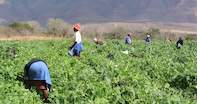
Green String Beans Crop Management
Vegetable Farming in South Africa
Crop Rotation
Green beans crops should preferably be rotated with other non-leguminous crops so as to avoid transmission of diseases such as Fusarium-Wilt, Anthracnose and Bacterial Blight.
Yield (tonnes per hectare)
Conservative: Six tonnes
Average: Eight tonnes
Good: 12+ tonnes
Harvesting
Start harvesting at ten weeks. Repeat harvest two to three days later to promote new flower buds so as to further increase production.
Thereafter daily harvesting can be done to catch the bean pods when they are young and tender as the beans ripen quickly, especially as the weather warms up into summer.
Harvest green beans in the early morning while it is still cool as the beans can dehydrate and wilt in warm conditions. It is important to get the beans to a cool storage area in less than two hours.
Storage
Store beans at four to five °C for a maximum of 7 days to ensure delivering a quality product. Preferably a relative humidity of above 90% should be maintained in the storage facility.
Pest and Disease control
It is imperative that the producer gets advice from their local extension officer or other chemical specialist for pest and disease control.
Pests
Nematodes, the most common problem being Root Knot Nematodes should be treated by fumigating soil prior to planting, American bollworm, aphids pumpkin fly, Red Spider Mite and Thrips are some common pests in Green bean production
Diseases
Some common diseases affecting Green Bean production are Rust, Bean Mosaic Virus, Fusarium Root Rot, Anthracnose, Bacterial Blight and Sclerotinia.
By
Louise Brodie